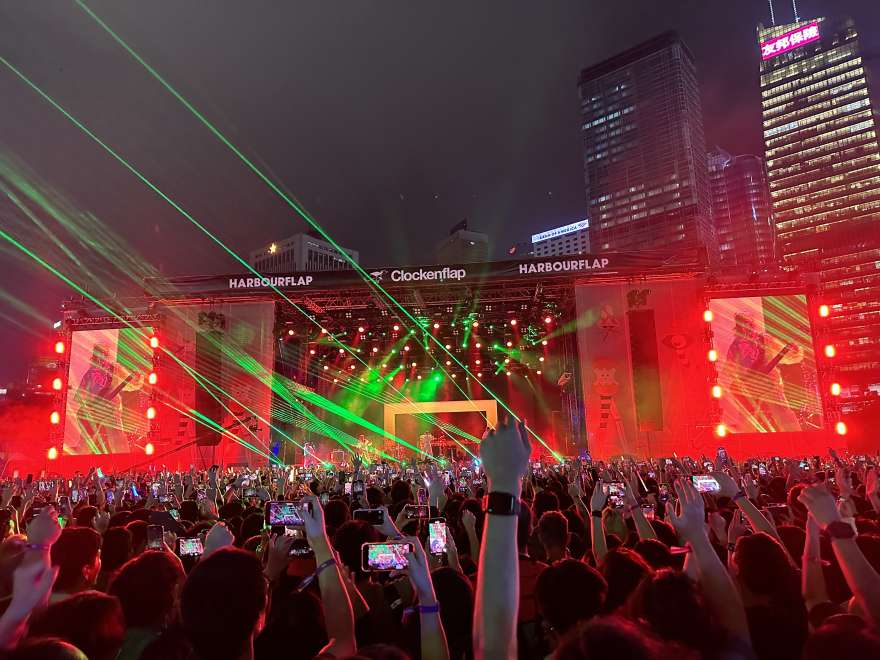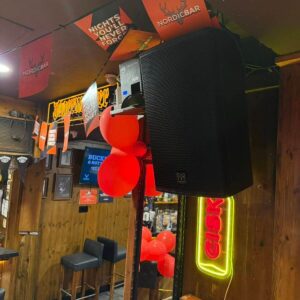HONG KONG:
Hong Kong’s Clockenflap festival returned to Central from 1-3 December with six stages of entertainment, including the main Harbourflap stage backed by the Hong Kong Peak and overlooking over the harbour to Kowloon.
Once again, MSI Japan was appointed as the production partner for the Harbourflap stage, with Bunshiro “Bun” Hote, Yasuhiko “Yasu” Watanbe, and Yukio “Eddie” Tanada handling sound design, with a particular emphasis on noise control. With the rear of the stage backed by government and residential properties, and complaints from residents in the past, the challenge was to limit audio heading in that direction. Accordingly, the team designed a Martin Audio MLA system with a cardioid subwoofer array of 30 MLX subwoofers, achieving close to 30dB rejection at the stage rear.
Two hangs of 15 Martin Audio MLA line array cabinets with one MLD downfill were plugged into the Display prediction software, enabling MSI to control audience coverage using the “hard avoid” feature at the rear to eliminate audio from onstage and from residents behind the stage. Limits were placed at the edges of the audience areas to ensure maximum focus on the crowd and prevent audio travelling across the water to Kowloon.
Clockenflap’s sound director Sem Cigna, who has worked with several different main stage systems on Clockenflap since 2016, had deployed a similar MLA configuration for a 2019 Gwen Stefani concert in Hong Kong. “I was able to experience how MLA could reduce the audio outside of the audience area without losing any impact for the audience,” Cigna explained.
When it comes to noise control for all six stages, the buck stops with Clockenflap’s production manager, Peter Gorton. “When the venue moved from Kowloon to Central several years ago, one of the biggest requests from the government was to manage the noise for the residents,” he says. There followed years of testing possible solutions, from hiring cranes to fly and test different line arrays at the site to situating large sandbags behind the subwoofers, blocking sound from the rear of the stage. MLA’s ability to eliminate noise from the back of the stage has meant that sandbags are a thing of the past. However, noise reduction is a crucial component of the festival, with three monitor stations around the site in Central and one across the water in Kowloon. Gorton is at pains to point out that while residents have adjusted to the annual festival in the city, he and his team don’t take this for granted, constantly striving to put on a great event without disturbing the neighbourhood.
“The MLA system has the punch and impact we were looking for, especially for bands like Japanese pop duo Yoasobi who were playing for the first time in Hong Kong,” said Gorton. “They sold out the Friday night and blew away the excited audience with their energy. Amazing to hear everyone in the crowd singing every word.” Yoasobi FOH engineer Fujita Kengi described the resolution of MLA as “standout”, allowing him to focus on the mix and create an impact for the audience.
Gorton also revealed plans for a Singapore festival in 2024 along with plans for more Hong Kong events.
Other acts to appear on the Harbourflap stage over the weekend included Britpop legends Pulp, hip hop stars De La Soul, Chinese alt rock band Omnipotent Youth Society, Taiwanese indie rockers No Party For Cao Dong, UK’s Idles and Chinese singer-songwriter Leah Dou.












